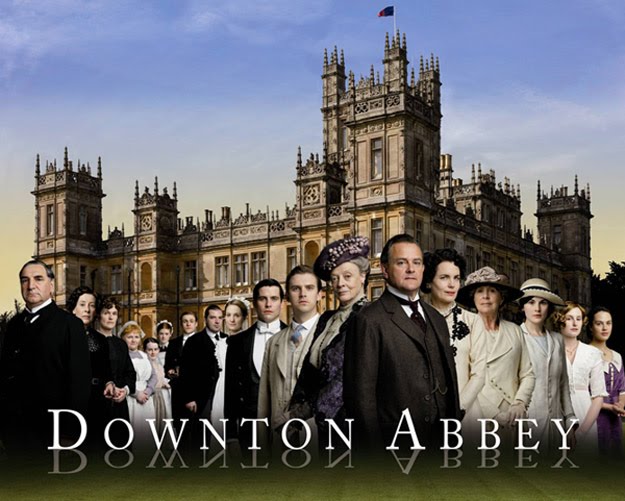Several months ago, Megan told us about a PBS series she loved: Downton Abbey.
“If it’s about zombies, we probably won’t watch it,” we said.
“No zombies. It’s set in England in the early 1900s, on this fabulous estate. You’ve got the aristocratic family, the Crawleys, and their servants. They…oh forget it, it’s complicated. I’ll stream the first episode and we’ll watch it, okay?”
And we did. Rob and I were hooked.
The lives of the Crawleys – Robert, his American wife Cora, and their three very different daughters , Mary, Edith, and Sibyl– unfold with great drama and human emotion alongside the lives of the multitude of servants who tend to them. The first episode opens the day after the sinking of the Titanic, April 16, 1912, so from the start, we sense we will see how some of the great historic events will impact British social hierarchy – and the lives of their servants.
We’re nearing the end of the third season and so far, have lived through the outbreak of World War I, the Spanish influenza pandemic, the Marconi scandal, the formation of the Irish free state. Now we’re into the rip-roaring 1920s, when the middle daughter – the only one not married – begins writing a column for a London newspaper, a totally scandalous thing for an aristocrat to do!
The lives of the servants, though, are as intriguing and complex as the lives of the Crawleys. We see the scheming that goes on among them to be first footman or the butler who dresses Robert Crawley every morning or the female servant who brings Cora Crawley breakfast in bed. We see their love dramas, their life dramas, their conflicts and triumphs. We see the relationships that develop between them and the Crawleys. After all, if you dress someone day in and day out, it’s inevitable that a relationship of some kind develops.
This is soap opera elevated to a new, riveting level.
The acting is superb. Maggie Smith, who plays the Dowager Countess, seems to have been born for this role – just as she was born for the role of Professor Minerva McGonagall in Harry Potter and the Half-Blood Prince. As Robert Crawley’s mother, she is the family caretaker – and also quite a trickster. She meddles in the affairs of the family and the servants in an always dignified way, behind the scenes, pulling strings. She’s got some great one-liners.
Carson, the head butler, is totally dedicated to the Crawley family. Mrs. Hughes, second in command below Carson, is a softie for the downtrodden, the vulnerable. In one episode, a kitchen maid is impregnated by a soldier staying at the abbey when it’s turned into a rehab center for wounded warriors from WWI. Even though the maid is fired, Mrs. Hughes takes her and her baby food, supplies, helps to support her.
One of the most interesting relationships occurs between John Bates, Robert’s personal valet, and Anna, who is the abbey’s head housemaid. There’s a tense period when he’s in prison for the murder of his first wife.
One of my favorite episodes included a scene with a Ouija board; the 1920s (third season) coincides with the rise of Spiritualism.
The series has won all sorts of awards and acclaim – Golden Globes, Emmys, even the Guinness Book of World Records because it earned the most nominations of any international TV series in the history of the Primetime Emmy Awards. By the third series, Downton Abbey had become one of the most widely watched TV shows in the world.
The writing is pitch perfect, the characters are cast exactly right, and you come away from each episode with a feeling that you’ve just glimpsed a real slice of history. You feel like a time traveler who has landed on the grounds of this magnificent estate. And you, the time traveler, knock at the kitchen door and are admitted by Anna or Mrs. Patmore, the head cook (Irish) at the abbey. Maybe you’re hired as kitchen help. Or as a chauffeur. Whatever your job as a servant, once you’re in, you become a member of a larger family.
And there are three distinct families in this show: the Crawleys, the servants, and the estate itself, the land, the history of the place, the physical building with its dozens of grand rooms, its spires, its intricate secrets. The consciousness about class – who you’re born to – is utterly clear. So when Sibyl, the youngest daughter, marries the Irish chauffeur, it becomes a family scandal. When Mary, the oldest daughter, marries her cousin (yeah, you read that right), because he has money they need for the estate, it’s a surprise when they actually fall in love.
In every episode, there are numerous surprises, plot twists, character revelations. And always, there’s this intriguing connection to history as it’s unfolding. Clothes, cars, and mores change accordingly. The evolving historical backdrop feels genuine.
I didn’t expect to like this show – not much that’s paranormal, no Mulder and Scully, no twilight zone. But what Downton Abbey has is humanity. It’s about how we evolve as a family, a culture, a country, nation, a world, a collective. It’s about people tossed into the cauldron of historical events and how they cope within the restrictive mores of their time. if you haven’t seen this show, by all means give it a try.









I am totally addicted to Dowton Abbey!
Oh, I love this show! I can hardly wait for the next season to start. It’s been an addiction for me since Day One. Glad to know you like it, too. 🙂
This was massive in the UK – it certainly gets you hooked! The building used was Highclere Castle in Hampshire, England.